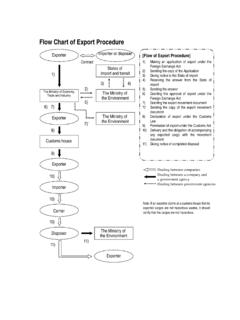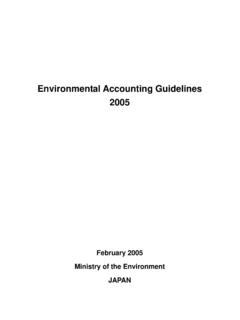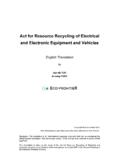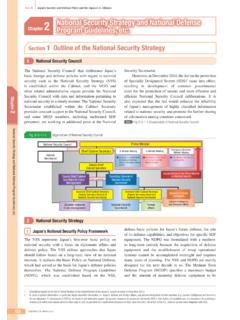Transcription of Japan's Climate Change Policies - env
1 Japan's Climate Change Policies 18th Mar. 201 . Ministry of the Environment, Japan Index 1. Japan s Greenhouse Gas Emissions in Global Context 2. Japan's Greenhouse Gas Emissions 3. Act on Promotion of Global Warming Measures 4. Japan's New Emissions Reduction Target for 2020. 5. Global Warming Measures toward Emissions Reduction Target for 2020. 6. Proactive Diplomatic Strategy for Countering Global Warming 7. Adaptation plan 2. Japan's Greenhouse Gas Emissions in Global Context 3. Global CO2 Emissions . Others South Africa China Australia Brazil Indonesia Mexico Global CO2 Emissions Saudi Arabia billion tons Iran Canada US. Japan South Korea Russia EU-27 1. India EU15 2.
2 Germany 1 Croatia became a member in 2013; therefore, not included in UK the figure. France Italy 2 EU 15 is EU member states at COP3 (Kyoto). Source IEA CO2 EMISSIONS FROM FUEL COMBUSTION 2013 EDITION 4. Global GHG Emissions (2010). Global GHG emissions in 2010 is approximately billion tonnes of CO2 eq. China and emit more than one-third of total global GHG emissions Share of CO2 from fuel combustion is more than 60% in total global GHG emissions Global GHG emissions by countries in 2010 Global GHG emissions by gas/source in 2010. Global GHG. emissions Global GHG. billion emissions tonnes (2010) billion CO2-equivalent units tonnes (2010). CO2-equivalent units 5. Source IEA CO2 EMISSIONS FROM FUEL COMBUSTION 2013 EDITION.
3 CO2 Emissions per Capita by Country 2011 . World Qatar United Arab Emirates Australia United States Saudi Arabia Canada Korea Russian Federation Japan Germany South Africa United Kingdom Islamic Rep. of Iran Italy China France Mexico Brazil Indonesia India Nigeria tCO2/capita . 0 5 10 15 20 25 30 35 40 45. Source IEA CO2 EMISSIONS FROM FUEL COMBUSTION 2013 EDITION 6. Cumulative CO2 Emissions after Industrial Revolutions (1850-2006). accounts approx. 30%. 75% of emissions are from developed countries (Japan: 4%). China, India, South Africa and Mexico account 9%,2%,1% and 1% respectively. Indonesia 1%. Brazil 1%. South Korea Other 1% 23% 29%. Mexico 1%. Australia 1%. South Africa 1% China 9%.
4 Italia 2% UK Russia Germany 8%. Canada 6%. 7%. 2% India France Japan 2% 3% 4%. Sources: World Resources Institute, Climate Analysis Indicators Tool 7. Japan's Greenhouse Gas emissions 8. Japan's Greenhouse Gas Emissions and Achievements Status for Emission Targets under the Kyoto Protocol Japan's total greenhouse gas emissions (preliminary figures) in FY2012 were 1,341 Mt CO2 eq. (an increase of compared to the base year (BY) and compared to the previous year (PY)). If the forest carbon sink measures target1 is achieved and Kyoto mechanisms credits2 are taken into account, the five-year average for total emissions during the first commitment period (CP1) of the Kyoto Protocol (FY2008-FY2012) shows an decrease compared to the total emissions of the base year; therefore, it is estimated that Japan will have achieved its target for the CP1 of the Kyoto Protocol (-6 % below base year level).
5 Actual total Amount to be deducted from Amount to be deducted from actual Emissions actual total emissions taking emissions total emissions taking into account 1,341 Mt (Billion t-CO2 eq.) into account the forest carbon the Kyoto mechanisms credits . sink measures target (+ from BY). 1,351 Mt 1,308 Mt < from PY Five-year average 1,282 Mt + from BY . 1,279 Mt 1,261 Mt (+ from BY) 1,257 Mt from BY . + from BY Forest carbon sink measures target of BY . 1,207 Mt ( from BY . Kyoto mechanisms credits of BY .. Kyoto Protocol - CP1.. Reduction Target: . -6% from BY. (1,186 Mt).. Five-year average for total emissions after deduction of . and from . from BY. Base Year (BY) 2005 2008 2009 2010 2011 2012 2008 2012.)
6 Five-year (2008-2012). (In principle, 1990) (Preliminary ( )Figures) . Average 1: Forest carbon sink measures target: About ( Mt CO2/yr.) of the base year emissions according to the Kyoto Protocol Target Achievement Plan. 2: Kyoto mechanisms credits: Acquired by the government: Total credits that were contracted as of FY2012 year-end through the Kyoto Mechanisms Credit Acquisition Program ( Mt) divided by 5 (yrs.). Acquired by the private sector: The amount of credits that were acquired by the Federation of Electric Power Companies of Japan (According to the Environmental Action Plan by the Japanese Electric Utility Industry [FY2009 to FY2013]). 3:Total emissions and removals for the Kyoto Protocol target will be finalized after the technical review process under the Kyoto Protocol and the Convention to be conducted in FY2014.
7 Also, the Kyoto mechanisms credits will be finalized after the true-up period for the first commitment period (expected to be completed in the second half of 2015 or later). 9. CO2 Emissions by Sectors and Actors (2012). (Preliminary figures). Municipal Waste Waste Industrial Waste, etc. Industrial Energy Conversion Processes 2%. Residential (Household heating and cooling, hot 3% water supply, electricity use, etc.). 7% Industrial Processes Residential (CO2 emissions from cement from electricity production, etc.). consumption Industries Household- 16% 11% 1%. 34% related: 1%. Energy Conversion from electricity Total Approx. 22% 16% (Self-consumption at consumption 13%.)
8 1,275Mt 3% power plants, gas plants, oil refineries, etc., ). from electricity Transportation 7%. from (passenger vehicles for electricity consumption 7% personal use) 5% Industries 20% consumption (Energy consumption in Commercial 1% manufacturing, construction, and Other mining, agriculture, forestry 18% Sectors and fishing industries). Transportation 20%. 34%. Commercial Excluding Industrial Processes and Waste Products, the and Other 12%. remaining 94% of CO2 emissions are related to energy (Office buildings, etc). consumption. Household Emissions, including personal vehicles and Transportation Business and municipal waste, comprise approximately 20% of (Freight vehicles, emissions.
9 The remaining 80% is from Business and Public sector. passenger vehicles for business use, ships, etc.). Public Sector-related: from electricity consumption means emissions from the Approx. 78%. use of electricity and heat which are purchased from companies such as electric companies, except private power generation. Actors 10. Trends in Energy oriented CO2 emissions by sector CO2 emissions from industries sector have been decreasing as production volume dropped because of financial crisis in late 2008. CO2 emissions from transportation sector have been decreasing by means of improvement in transportation efficiency etc. CO2 emissions from commercial and other sector have been increasing by expanding floor area as well as worsening emission factor due to the increase in fossil fuel, power generation share after the earthquake.
10 CO2 emissions from residential sector have been increasing by growth in energy use in response to increasing number of household as well as worsening emission factor due to the increase in fossil fuel power generation share after the earthquake Emissions from energy conversion sector (power plant etc.,) have been increasing in response to energy demand increase such as electricity. 11. (Reference) GHG emission and removal inventory Change in energy mix for power generation after the earthquake After the earthquake disaster, nuclear power plants have been shut down for maintenance, and the share of the nuclear power generation dropped drastically.( Oi nuclear power plant and 4 were restarted in July 2012).
















